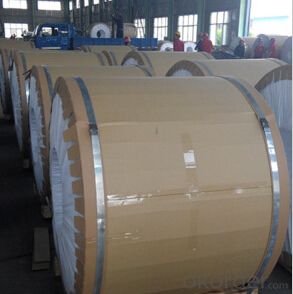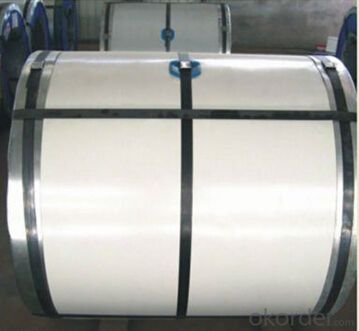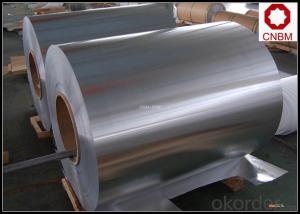DC Hot Rolled Aluminum Coil 5052/1060/1070/1050/1100/3003/3004/3A21/5A52
- Loading Port:
- Tianjin
- Payment Terms:
- TT OR LC
- Min Order Qty:
- 25 m.t.
- Supply Capability:
- 10000 m.t./month
OKorder Service Pledge
OKorder Financial Service
You Might Also Like
Aluminum Coils description:
Model NO.:1060/1070/1050/1100/3003/3004/3A21/5052/5083/6061
Alloy:Alloy
Type:Aluminum Coils
Surface Treatment:Mill Finish
Shape:Flat
Temper:O - H112
Grade:5000 Series
Application:Decorations, Heat Sink, Transportation Tools, Door & Window, Glass Wall, Ship Building
Width:1000-1550
Export Markets:Global
1.Specification
1.Item:aluminium hot rolled coil
2.Grade:1060/1070/1050/1100/3003/3004/3A21/5052/5083/6061
3.Thick:1-15mm
4.Width:1000-1550mm
Trademark:Bizrolling
Packing:Wooden Case
Standard:ISO 9001:2000,FDA Certificate,KOSHER Certificate
Origin:China
HS Code:76071190
Production Capacity:3000 Mt Per Month
2.Picture of Goods

3.Machinery equipment


FAQ:
Acceptable payment term and way?
T/T,L/C, T/T + L/C, D/P
Acceptable price term
FOB CNF CIF DDU CPT
Do you accept OA payment terms?
Yes, sure, but it normally depending on the order value
Do you have QC team?
Yeah, sure, our QC team is very important, they will keep the qualitycontrol for our products.
What is the validity of your quotation?
Normally 7 days.
What is your advantage?
24 hour quick response /Customer oriented/ Credit foremost/ Top quality Excellent
What is your acceptable payment term?
TT,LC,OA etc
- Q: I mean, besides the light weight and other graces of Aluminium and Carbon, Steel frames are absolutely out-dated and they have nothing to do these days... or it is still possible to enjoy a nice ride on our heavy old pals?
- Ah, I took a nice 40mi spin on my steel road bike today. Maybe it's not as fast as my other rides...I don't know, I'm too busy enjoying the ride. Steel is timeless.
- Q: How are steel coils used in the manufacturing of automotive chassis?
- Steel coils are used in the manufacturing of automotive chassis as they provide the necessary strength and durability required to support the weight of the vehicle and withstand various stresses and impacts. These coils are processed and formed into various structural components, such as frame rails and cross members, which form the foundation of the chassis.
- Q: How are steel coils used in the production of roofing and siding?
- Roofing and siding materials heavily rely on steel coils as a vital element. These coils, crafted from high-quality steel, undergo several processes to convert them into the final products used in roofing and siding. To start with, the steel coils are unwound and flattened to obtain a smooth steel sheet. Subsequently, this sheet is thoroughly cleansed to eliminate any impurities or contaminants. The cleansing procedure involves treating the steel's surface with chemicals and rinsing it meticulously to ensure a spotless and sleek surface. Following this, the steel sheet receives a protective layer to enhance its durability and resistance against corrosion. This coating can be executed through various techniques such as hot-dip galvanizing, electro-galvanizing, or applying a metallic or organic layer. The preferred method of coating depends on the desired properties and aesthetic requirements of the roofing or siding material. After the coating process, the steel sheet is shaped and formed into the desired structure and profile. For roofing purposes, the steel sheet is commonly corrugated or shaped into interlocking panels. This facilitates easy installation and guarantees a secure and weather-resistant roofing system. Similarly, for siding applications, the steel sheet can adopt various profiles like horizontal or vertical panels, shingles, or shakes. Once the steel sheet is formed, it may undergo additional treatments to improve its performance. This can involve applying a protective coat of paint or other finishes to enhance its appearance and resistance against fading, chipping, or scratching. The steel coils can also be embossed or stamped with patterns or textures to provide aesthetic appeal. In conclusion, steel coils play a vital role in the production of roofing and siding materials. They offer strength, durability, and weather resistance, making them an ideal choice for safeguarding structures from the elements. Furthermore, steel coils provide versatility in terms of shape, profile, and finish, allowing for a wide range of design options for roofing and siding applications.
- Q: How do steel coil manufacturers meet customer specifications?
- Steel coil manufacturers meet customer specifications by carefully analyzing the requirements provided by the customer and utilizing advanced production techniques to ensure precise dimensions, mechanical properties, and surface finishes. They employ strict quality control measures throughout the manufacturing process, including rigorous testing and inspections, to ensure that the coils meet the specified standards. Additionally, manufacturers often collaborate closely with customers to understand their unique needs and provide customized solutions that meet or exceed their expectations.
- Q: How are steel coils used in the production of steel pipes?
- Steel pipes rely on steel coils as a vital element in their production. These coils serve as the primary material for manufacturing the pipes. The initial phase of the process involves unwinding the steel coil and introducing it into a machine referred to as a slitter. The slitter then cuts the coil into narrower strips of the desired width. This width plays a crucial role as it determines the diameter of the resulting steel pipes. Once the steel coil has been sliced into strips, the subsequent step is to feed these strips into another machine known as a forming mill. The forming mill gradually shapes the strips into a cylindrical form by passing them through a sequence of rollers. These rollers apply pressure and bend the strips until they assume the shape of a pipe. To ensure the pipes' durability and strength, they undergo a welding procedure. The ends of the strip are heated and fused together using a high-frequency electric current, creating a seamless weld along the entire length of the pipe. This weld provides structural integrity and prevents any leakage or weak points in the pipe. After the welding process, the pipes undergo a sizing and shaping procedure. They are passed through additional rollers, gradually reshaping them to achieve the desired dimensions, including the final outer diameter and wall thickness. Finally, the pipes are cut to the desired length and undergo various finishing procedures, such as straightening, testing, and coating. These finishing steps guarantee that the pipes meet the required specifications and are ready for use in various applications, such as plumbing, construction, and the oil and gas industries. In conclusion, steel coils serve as the foundation for the production of steel pipes. They are slit, formed, welded, sized, shaped, and finished to create robust and high-quality pipes suitable for diverse industries.
- Q: How are steel coils inspected for edge quality?
- Inspectors use a combination of visual inspection and non-destructive testing methods to assess the edge quality of steel coils. During visual inspection, trained inspectors carefully examine the entire length of the coils to detect visible defects like cracks, chips, or uneven edges. Non-destructive testing methods, including ultrasonic testing and magnetic particle inspection, are also utilized to uncover any hidden defects or imperfections in the edges of the steel coils. Ultrasonic testing employs high-frequency sound waves to identify internal flaws or discontinuities in the steel, while magnetic particle inspection utilizes magnetic fields and particles to detect surface or near-surface defects. Both visual inspection and non-destructive testing methods are vital in guaranteeing the quality of the steel coil edges. Manufacturers can identify and resolve any defects or imperfections by conducting these inspections, thereby ensuring that the coils meet the required quality standards.
- Q: would you consider steel a flexible substance...i am debating this with my coworkers.Thanks,
- Steel is a flexible material. It can be deformed and return to it's original shape up while the stress applied is still in the elastic range. How flexible depends on size, shape, and alloy. Some alloys are more flexible than others and a lot of this is controlled by carbon content.
- Q: What are the common methods of slitting or shearing steel coils?
- The common methods of slitting or shearing steel coils include rotary shear, guillotine shear, and laser cutting.
- Q: How are steel coils inspected for hardness using hardness testers?
- To assess the strength and durability of steel coils, hardness testers are employed to examine their hardness. Hardness testers are specialized devices used to gauge a material's resistance to indentation or penetration. For steel coils, Rockwell or Brinell testers are commonly utilized. Both methods entail exerting a precise force onto the surface of the coil and measuring the depth of indentation or size of the impression made. In the case of Rockwell testing, a steel ball or diamond cone is pressed onto the coil's surface with a predetermined force. The depth of penetration is then measured and compared to a standardized scale in order to determine the hardness value. Different scales are employed based on the size and type of indenter in use. On the other hand, Brinell testing involves using a spherical indenter made of tungsten carbide or hardened steel. This indenter is pressed onto the coil's surface with a known force, and the resulting indentation is measured and compared to a standardized table to determine the hardness value. Both methods provide a quantitative measure of the steel coil's hardness, which serves as an indicator of its ability to resist deformation, wear, and cracking. The hardness test results are subsequently utilized to ensure that the steel meets specific quality standards or customer requirements. It is important to note that the inspection process may involve sampling, where representative sections of the steel coil are tested, or it may involve testing the entire coil, depending on the specific inspection requirements. Additionally, accurate and reliable results necessitate proper calibration and maintenance of the hardness testers.
- Q: I have a job where I'm required to wear ANSI certified steel toed boots or shoes(so long as its ANSI). Thing is, I'm a vegan. I do NOT want to buy leather, and I will go to great lengths to buy a non leather shoe/boot I can wear on the job! I AM currently borrowing my dad's leather ANSI boots, but would very much love to be able to rock a pair of cruelty free boots/shoes on the job!It does not have to be certified vegan just all man-made materials and no leather/sued and other such stuff where animals have to die. It would make me no better than the massive slaughterhouse industries and such. Valueing money of ver live/morals. I don't want one of the first things I need to do in my manufacturing job is compromising my morals. :3So if you know of an ANSI vegan friendly boot brand PLEASE TELL ME! *gets on knees begging*Money isn't really an option for me, I'll just continue borrowing my dad's boots till I save up enough!Thanks in advance! :D
- Sears okorder /
Send your message to us
DC Hot Rolled Aluminum Coil 5052/1060/1070/1050/1100/3003/3004/3A21/5A52
- Loading Port:
- Tianjin
- Payment Terms:
- TT OR LC
- Min Order Qty:
- 25 m.t.
- Supply Capability:
- 10000 m.t./month
OKorder Service Pledge
OKorder Financial Service
Similar products
Hot products
Hot Searches
Related keywords


























